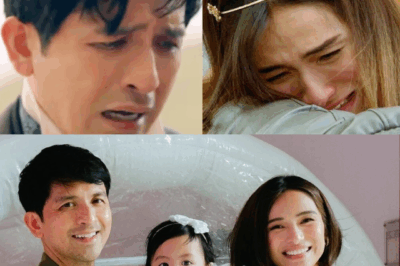He walked out slowly, a bandage wrapped around one eye, but his voice was clear, steady, and full of life. “I still have strength,” he told the crowd of reporters and fans gathered outside the hospital. In that moment, Dharmendra—Bollywood’s beloved “He-Man”—proved once again that true strength isn’t just in muscles or fame. It lives in the spirit.
At 89, most would choose rest, privacy, and silence. But Dharmendra, a living legend who has graced Indian cinema for over six decades, stepped forward with grace after undergoing a major eye surgery—specifically, a graft procedure for his cornea. The news shocked and moved fans across generations, many of whom had grown up watching him on screen, fighting villains, charming heroines, and dancing under moonlit skies.
The actor, who has long been admired for his physical fitness and vibrant energy, did not shy away from the cameras after his procedure. Instead, he faced them, smiling and engaging with warmth. “Abhi bhi bohot dum hai,” he said with quiet pride. That single statement—simple, sincere—sent a wave of relief and admiration across social media. It reminded everyone that the Dharmendra they knew was still standing tall.
Dharmendra’s life has always been marked by resilience. Born in 1935 in Punjab, he entered the film industry during a time of transition and turbulence. With no godfather or industry connections, he built his legacy on sheer hard work, charisma, and talent. From his early roles in Bandini and Phool Aur Patthar to blockbuster classics like Sholay, Satyakam, and Chupke Chupke, he became a symbol of masculine grace and strength.
But behind the camera, he has also endured personal storms—health scares, emotional battles, the weight of expectations. And now, at an age when most fade into quiet retirement, he chooses to live fully, to face each challenge as a new role to conquer.
Sources close to the family have confirmed that the eye surgery was delicate but successful. The actor had been experiencing discomfort and diminishing vision in one eye, leading doctors to recommend corneal grafting—a procedure that, while routine for some, carries more risk at his age.
Still, Dharmendra’s recovery has been steady, and his spirits high. Videos and photos captured outside the hospital show him greeting paparazzi, flexing his arm with a smile, and assuring fans that he’s doing just fine. It’s not just his body that has aged well—it’s his spirit, his charm, his sense of duty to his audience.
“Love you, my audience and my fans,” he was heard saying, his voice filled with sincerity. For a man who has given decades of his life to cinema, this connection with his fans seems as vital as ever.
In an age when stars often retreat behind publicists and curated social media posts, Dharmendra remains refreshingly human. Vulnerable, open, unafraid to show his scars or share his struggles. This recent surgery has only deepened the respect people feel for him. Not because he had to go through it—but because of the way he chose to face it.
Tributes poured in from fellow actors and fans alike. Ranveer Singh, who often refers to Dharmendra as the “Original He-Man of Bollywood,” called him an inspiration. Wrestler Geeta Phogat posted a heartfelt message, praising his undying spirit. Across platforms, hashtags like #GetWellSoonDharamji and #HeManForever began trending.
Even younger fans, many of whom never saw his golden-era films in theaters, connected with his story. Because Dharmendra represents more than nostalgia—he embodies the idea that aging doesn’t mean surrender. That dignity and strength can shine even through a hospital visit, a bandaged eye, or a tired step.
And while the public was still talking about his health, Dharmendra surprised everyone with an announcement: he’s not done yet. After a successful 2024 appearance in Teri Baaton Mein Aisa Uljha Jiya with Shahid Kapoor and Kriti Sanon, he’s preparing for his next big role in Sriram Raghavan’s Ikkis, a war drama based on the life of Second Lieutenant Arun Khetarpal.
At nearly 90, he’s reading scripts, attending shoots, and embracing challenges with the heart of a man half his age.
So what makes Dharmendra different? Maybe it’s his Punjabi grit. Maybe it’s the fire of an old-school actor who never forgot the hunger of his early days. Or maybe, it’s something simpler—the refusal to be defined by age, illness, or expectation.
There is something heartbreakingly beautiful about seeing a hero age. About watching someone who once embodied invincibility, now walk a little slower, speak a little softer, but still carry that same fire in their eyes. For many, Dharmendra is not just a film star—he’s a grandfather figure, a reminder of simpler times, a symbol of timeless grace.
His eye may need healing, but his vision remains crystal clear—to live fully, to love deeply, and to never stop moving forward.
In a time when youth is worshipped and aging is hidden, Dharmendra stands tall with a message: there is beauty in growing older, there is pride in facing pain, and there is unmatched power in choosing hope, again and again.
As the cameras flashed and he stepped into his car, a fan shouted, “We love you, Dharamji!” And with a half-smile, he waved back.
The legend lives on—not just in film reels, but in hearts, in resilience, and in every step forward, no matter how slow.
News
New Life Abroad? Kathryn Bernardo Allegedly Moving In With Mayor Mark Alcala in Australia
It started as just another rumor—until it didn’t. Fans of Kathryn Bernardo were left stunned as news began to circulate…
Dennis Trillo Breaks Down Over What Happened to Jennylyn Mercado’s Son with Patrick Garcia
Dennis Trillo has always been known as one of the most composed and private actors in showbiz. Calm, respectful, and…
Annabelle Rama Slams Barbie! Richard Gutierrez’s Breakup Linked to Third Party and Albay Exit
It was a storm no one expected, but now that it’s here—everyone’s watching. In what began as quiet speculation and…
Paulo Avelino Breaks Silence: Why He Held Back from Janine Gutierrez
For years, their names were linked by something electric yet invisible—Paulo Avelino and Janine Gutierrez, two stars whose chemistry burned…
Marian vs. Karylle? Heated Scene Between Actresses Goes Viral—What Really Happened?
What was meant to be a glamorous event quickly turned into one of the most talked-about showbiz moments of the…
Trouble at Home? Kathryn Bernardo Reportedly Leaves After Mommy Min Disapproves of Mark Alcala
In a shocking twist that has sent waves across the fandom, reports are now surfacing that beloved actress Kathryn Bernardo…
End of content
No more pages to load












